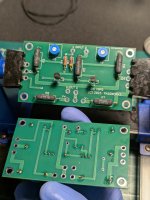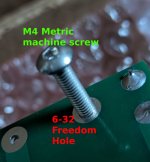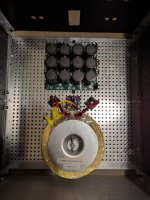Group Request -
The build guide for the F5m is mostly complete. All that remains (hopefully) is proofing and feedback. Anyone that's willing to give it a look and provide feedback, PM me.
It extremely valuable to have an international audience with English as a second language. I tend to use a lot of words (shocking) and vernacular that may not translate well. For electronics, it would be wonderful to ensure clarity if people are using translation tools and/or if certain words do not easily translate.
and vernacular that may not translate well. For electronics, it would be wonderful to ensure clarity if people are using translation tools and/or if certain words do not easily translate.
Seasoned veterans to beginners are more than welcome. I could use specific assistance with one detail re: mains safety for non-USA builds.
All I ask is candid feedback and to understand that all feedback is greatly appreciated but may not be implemented.
Cheers,
Patrick
The build guide for the F5m is mostly complete. All that remains (hopefully) is proofing and feedback. Anyone that's willing to give it a look and provide feedback, PM me.
It extremely valuable to have an international audience with English as a second language. I tend to use a lot of words (shocking)
 and vernacular that may not translate well. For electronics, it would be wonderful to ensure clarity if people are using translation tools and/or if certain words do not easily translate.
and vernacular that may not translate well. For electronics, it would be wonderful to ensure clarity if people are using translation tools and/or if certain words do not easily translate.Seasoned veterans to beginners are more than welcome. I could use specific assistance with one detail re: mains safety for non-USA builds.
All I ask is candid feedback and to understand that all feedback is greatly appreciated but may not be implemented.
Cheers,
Patrick
Hi Everyone -
The F5M guide is now "live".
There are a few questions I anticipate -
- When will there be a wiring or a diagram for 220/240 VAC? Hopefully within two weeks. In the interim, if anyone doesn't know how to wire it for their mains voltage, post here in the forums, and you'll get a speedy response from the fantastic members here.
- Why are there only Antek transformers, and will you add more types / brands? They're commonly used, and they're great. We may add more. If there are specific transformers users love, post here or PM, and we'll see if we can get them added and/or provide guidance.
Have fun!
Most importantly - there was a herd of volunteers that immediately responded and dove in to help proof the guide, suggest valuable additions, and generally keep me from going (even more) insane. Were it not for them, it easily could have been another few weeks to finish. I shouldn't be surprised, but I'm continually thrilled with this incredible community.
All F5M builders please give a thank you (in no particular order) to: @Halauhula; @twofires @northpaw; @Stereobob; @Dennis Hui; @ClaudeG; @Jacruzer787; and @budwiser
If I've missed anyone, my humble apologies. You all Rock!

Is the guide "done"? - never. If anyone has suggestions, please feel free to send them via PM.
BTW - I have to admit, I kinda dig the 2U chassis. I fully admit that I was skeptical. I'm now smitten. It's cute as a button, and if you don't mind a little warmth, it's wonderful. FABs may choose to bump up the bias a touch above what is covered in the guide based on their tolerance/experience. Coming to a diyAudiostore near you... soon...
F5M Guide
The F5M guide is now "live".
There are a few questions I anticipate -
- When will there be a wiring or a diagram for 220/240 VAC? Hopefully within two weeks. In the interim, if anyone doesn't know how to wire it for their mains voltage, post here in the forums, and you'll get a speedy response from the fantastic members here.
- Why are there only Antek transformers, and will you add more types / brands? They're commonly used, and they're great. We may add more. If there are specific transformers users love, post here or PM, and we'll see if we can get them added and/or provide guidance.
Have fun!
Most importantly - there was a herd of volunteers that immediately responded and dove in to help proof the guide, suggest valuable additions, and generally keep me from going (even more) insane. Were it not for them, it easily could have been another few weeks to finish. I shouldn't be surprised, but I'm continually thrilled with this incredible community.
All F5M builders please give a thank you (in no particular order) to: @Halauhula; @twofires @northpaw; @Stereobob; @Dennis Hui; @ClaudeG; @Jacruzer787; and @budwiser
If I've missed anyone, my humble apologies. You all Rock!


Is the guide "done"? - never. If anyone has suggestions, please feel free to send them via PM.
BTW - I have to admit, I kinda dig the 2U chassis. I fully admit that I was skeptical. I'm now smitten. It's cute as a button, and if you don't mind a little warmth, it's wonderful. FABs may choose to bump up the bias a touch above what is covered in the guide based on their tolerance/experience. Coming to a diyAudiostore near you... soon...

F5M Guide
Last edited by a moderator:
^ Is it broken? I tried with my "credentialed" account and a standard account with no privileges.
Anyone else having issues, or is the ZM block working properly?
Anyone else having issues, or is the ZM block working properly?

working now
I tried previously from my usual browser with all credentials, and no go; just in case I tried with generic browser (no credentials) and it also didn't work
I tried previously from my usual browser with all credentials, and no go; just in case I tried with generic browser (no credentials) and it also didn't work
Great write up! Well done.
I love the extra info about bad luck near the end.
I love the extra info about bad luck near the end.

Important note is left out
"It's also bad luck having Odd number of FW amps in home; any number bellow 10 is Odd"

"It's also bad luck having Odd number of FW amps in home; any number bellow 10 is Odd"
Wow, setting the gold standard on these build guides. That is going to help a lot of folks with successful builds.
Thanks to everyone who made that amazing build guide possible! Extra special thanks to @ItsAllInMyHead !
Certainly that was a LOT of hard work and time to put together. The approach to help "early career builders", detailed explinations that include the "why with the what", and so much well thought out guidance is top notch. I picked up some great knowledge, tips, & tricks just reading through it.
Makes me want to build another F5m. I'm still not up to 10 FW amps.... yet
Thanks to everyone who made that amazing build guide possible! Extra special thanks to @ItsAllInMyHead !
Certainly that was a LOT of hard work and time to put together. The approach to help "early career builders", detailed explinations that include the "why with the what", and so much well thought out guidance is top notch. I picked up some great knowledge, tips, & tricks just reading through it.
Makes me want to build another F5m. I'm still not up to 10 FW amps.... yet

Extra special thanks from me to @ItsAllInMyHead!!!!!
People like he, 6L6, Mark Johnson (just to name a few) and of course Mr Pass himself, make this community so wonderful to be part of.
People like he, 6L6, Mark Johnson (just to name a few) and of course Mr Pass himself, make this community so wonderful to be part of.
^ +7Extra special thanks from me to @ItsAllInMyHead!!!!!
This was a labor of love from ItsAllInMyHead, and it shows. The rest of us pitched in maybe a couple of hours in the final 36 hours before launch, just to create trouble for him, but he triumphed nonetheless. 🏆
Lazy Sunday - the kiddo decided to go off an play Switch rather than build her Lego with Dad, so Dad did a tiny bit of his big kid Lego in between boring domestic things.
I've been following the new guide as I go along, and can report the trimmer pot test works as described (I have Opposites Day trimpots). I also like how the guide gently directs you to look at the circuit diagram rather than just saying 'put the 47k ohm resistor in R2' etc. Subtle nudging towards self-improvement. I like it.

I've decided I like Multicore solder more than Kester. If nothing else, it smells better. 🤪
I've been following the new guide as I go along, and can report the trimmer pot test works as described (I have Opposites Day trimpots). I also like how the guide gently directs you to look at the circuit diagram rather than just saying 'put the 47k ohm resistor in R2' etc. Subtle nudging towards self-improvement. I like it.

I've decided I like Multicore solder more than Kester. If nothing else, it smells better. 🤪
Re: Step 48
I've learned the hard way that if you cut transformer wires to exact length, it makes it difficult to rotate it to eliminate hum that's sometimes caused by the transformer position.
I've learned the hard way that if you cut transformer wires to exact length, it makes it difficult to rotate it to eliminate hum that's sometimes caused by the transformer position.
^ Love it! 

Amended the first note. It now reads:
"Note - Some people never cut their transformer wiring to length in order to ensure they can use them in multiple projects. It is your choice. Also, leaving the wires a little longer will allow you to rotate the toroid into the perfect position to minimize hum. This may be particularly important in tighter builds and for those with sensitive speakers."
Edited to add the note to the note to the note re: sensitive speakers.


Amended the first note. It now reads:
"Note - Some people never cut their transformer wiring to length in order to ensure they can use them in multiple projects. It is your choice. Also, leaving the wires a little longer will allow you to rotate the toroid into the perfect position to minimize hum. This may be particularly important in tighter builds and for those with sensitive speakers."
Edited to add the note to the note to the note re: sensitive speakers.
Another day, another Digikey order because I made an assumption...

😂
It does say 6-32 right there in the BOM in Nelson's document - I have no excuses.
Otherwise, work proceeds slowly but surely.

(the label on the transformer is for my weirdo trimpots, and doesn't apply to most folks)
The layout is tentative - I'm not sure if having the AC hookup in the middle there is going to work out. Everyone else seems to put theirs on one side - is that to keep the primary and secondaries wires far apart, or is it just because most cases don't have enough depth to put it in front of the transformer? I was sweating this, but then I see some builds where the wires just go wherever and everything seems to work out fine, so... 🤷♂️ I can easily unbolt it all and drill another hole for the AC wiring to pop up to one side instead of the middle if need be, but I might try this first and see what happens, as it otherwise keeps AC as far from the amp boards as possible.
I notice the guide says not to sweat the wire guage too much, but I'm wondering if there's any part of the build that would need thicker than the 18AWG I have to hand. The only place I can think is between the bridge rectifiers and the bipolar supply board, and even then, that would only be briefly as the caps charge? The secondary wires on my transformer are 14AWG, which gives me pause. My transformer is 500VA and the caps I selected give me 120000uF total capacitance. My bodgy math of 500va/18VAC = 27.8A / 2 rectifiers = roughly 14amps max? And even then it shouldn't be pulling that hard with all the thermistors in place? I dunno, let me know if I'm misunderstanding everything (likely).

😂
It does say 6-32 right there in the BOM in Nelson's document - I have no excuses.
Otherwise, work proceeds slowly but surely.

(the label on the transformer is for my weirdo trimpots, and doesn't apply to most folks)
The layout is tentative - I'm not sure if having the AC hookup in the middle there is going to work out. Everyone else seems to put theirs on one side - is that to keep the primary and secondaries wires far apart, or is it just because most cases don't have enough depth to put it in front of the transformer? I was sweating this, but then I see some builds where the wires just go wherever and everything seems to work out fine, so... 🤷♂️ I can easily unbolt it all and drill another hole for the AC wiring to pop up to one side instead of the middle if need be, but I might try this first and see what happens, as it otherwise keeps AC as far from the amp boards as possible.
I notice the guide says not to sweat the wire guage too much, but I'm wondering if there's any part of the build that would need thicker than the 18AWG I have to hand. The only place I can think is between the bridge rectifiers and the bipolar supply board, and even then, that would only be briefly as the caps charge? The secondary wires on my transformer are 14AWG, which gives me pause. My transformer is 500VA and the caps I selected give me 120000uF total capacitance. My bodgy math of 500va/18VAC = 27.8A / 2 rectifiers = roughly 14amps max? And even then it shouldn't be pulling that hard with all the thermistors in place? I dunno, let me know if I'm misunderstanding everything (likely).
That does sound less worrying. 🙂 My main concern was on inrush as the capacitor bank charges. I've never built a linear supply this big before, so I honestly don't know how big that draw is, and for what kind of duration. No doubt there's math I could learn to calculate this.Assuming you have 1.4 amps bias, then for a single channel you will have 2.4 amps of load, and with the power transformer you have chosen, it will will provide plenty of headroom. 🙂
But the more I google, the sillier my concerns seem. The advice seems to be that the absolute max current any given wire can handle is to do with how long the insulation can do its job before it deforms due to the conductors heating up. I don't figure it's likely 18awg would heat up sufficiently to deform PVC unless something was direly wrong for a significant length of time, at which point the fuse would long since have blown.
And so I come full circle to what the guide told me in the first place: don't sweat the wire gauge. 😅
18awg copper wire should be up to the task.
However, the only comment I have is that probably your 120,000 uF capacitance is overkill; Mr. Pass has 12 x 4,700uF caps in the F5M doc, and IIRC he recommends 60,000 uF most of the times. Of course builders can go for more capacitance, and many of us often do. But higher is not always necessarily better. 🙂
However, the only comment I have is that probably your 120,000 uF capacitance is overkill; Mr. Pass has 12 x 4,700uF caps in the F5M doc, and IIRC he recommends 60,000 uF most of the times. Of course builders can go for more capacitance, and many of us often do. But higher is not always necessarily better. 🙂
- Home
- Amplifiers
- Pass Labs
- F5m kit